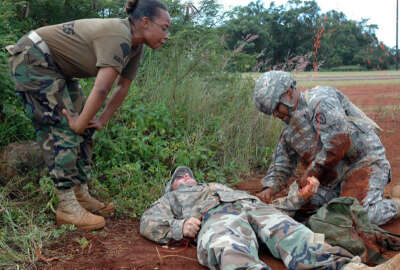
DoD plans to cut 18,000 uniformed health positions, but no clear plan to replace them
The military is already starting to downsize its uniformed medical cadre, but there is no clear plan to replace the 18,000 positions it's eliminating with civil...
Best listening experience is on Chrome, Firefox or Safari. Subscribe to Federal Drive’s daily audio interviews on Apple Podcasts or PodcastOne.
The Defense Department’s 2020 budget makes clear that it expects to have a lot fewer uniformed medical personnel providing care in its hospitals and clinics in the coming years. What’s not clear is who, exactly, will replace them.
During the Pentagon’s budget rollout last month, senior officials indicated the department intends to convert a large number of military medical billets to civilian ones so that it can redirect uniformed manpower toward more direct warfighting functions.
And indeed, the written budget justification DoD submitted later for the Defense Health Program contemplates a reduction of nearly 18,000 personnel — a 22 percent decrease compared to the size of the active duty medical force in 2019. But there are no corresponding increases for civilian staff in the 2020 budget. In fact, their numbers would shrink slightly as well.
Although DoD has determined it needs the military manpower for other operational and modernization priorities, it hasn’t yet determined how it will replace the medical care that’s no longer being delivered by those military members, Vice Adm. Raquel Bono, the director of the Defense Health Agency told the House Appropriations Committee on Wednesday.
“The military departments and DHA are working closely together on the process for implementing these reductions responsibly and carefully. We are now identifying the alternative models — civilian hires, contract staff, military-civilian partnerships, or use of existing TRICARE networks — that will best meet the needs of beneficiaries,” she said. “We will continue to meet all standards for timely access for our beneficiaries, and while care delivery locations may change, our commitment to provide high quality healthcare will remain steadfast.”
Even so, the military services have already started the process of reallocating uniformed medical billets to other functions, despite the fact that Congress has not yet considered or approved the manpower reallocation.
Vice Adm. Forrest Faison, the Navy’s surgeon general, said the Navy has already stopped filling some of the medical positions Congress funded for 2019.
“For the billets that are coming offline in FY 20, those positions are not being filled now as they become vacant,” he said. “We’re working with our personnel command to identify those that have got critical impact to the fleet and to remote areas and put personnel in those locations as we work through this. But there are billets that are not being filled now because people cannot complete a full three year tour, because the position is coming out of the [health] budget.”
Related Stories
The reductions were driven, at least in part, by a Congressionally-mandated report detailing how many and what types of medical professionals the military services need to fight wars. The report was delivered two years past its deadline, and its contents are classified.
Rep. Pete Visclosky (D-Ind.), the chairman of the House Defense Appropriations Subcommittee, said that fact alone complicates lawmakers’ efforts to assess DoD’s plan to do away with thousands of military medical positions.
“It makes it very difficult for the committee to have open conversations and ask others who might be qualified to pass judgment as whether or not the recommendations are positive or not,” he said. “I mean, if I’m looking for somebody else’s opinion about whether this makes any sense, I can’t talk to anybody about it. It’s classified.”
Thomas McCaffery, the principal deputy assistant secretary of Defense for health affairs, said DoD knows it needs to give lawmakers more information, but defended the classification decision.
“The report required us to evaluate a variety of scenarios, including vetted operational plans that are classified,” he said. “We have shared that report to Congress, but we’ve done so in a way to protect that classification. What we put forward is a first cut…but we recognize we have more work to do. One of the things that the Congress has asked us to do is move from separate service-specific methodologies to a department-wide kind of common methodology that identifies joint requirements. And we’re working on that now.”
Although DoD’s report is classified, several published studies have questioned whether the Pentagon is making the best use of military personnel for day-to-day medical functions.
The military services have long believed that having their uniformed medical personnel engaged in patient care in stateside military treatment facilities is key to maintaining a medical force that’s ready to deploy to combat zones.
But some of the specialties in demand at those stateside MTFs — like pediatricians and obstetricians — don’t match well with the military’s battlefield medical requirements.
For example, an assessment published last May by the Institute for Defense Analyses noted that the military “over-staffs” positions needed to care for family members and retirees, and has a deficit of general surgeons and emergency physicians. IDA estimated DoD could save more than $1 billion over five years by converting military positions that provide care in just eight specific specialties to civilian health jobs.
Copyright © 2024 Federal News Network. All rights reserved. This website is not intended for users located within the European Economic Area.
Jared Serbu is deputy editor of Federal News Network and reports on the Defense Department’s contracting, legislative, workforce and IT issues.
Follow @jserbuWFED






